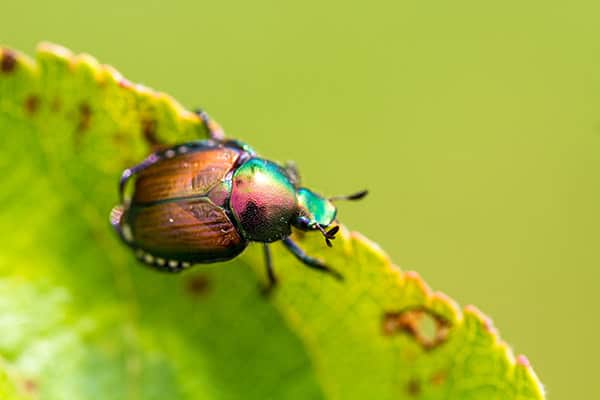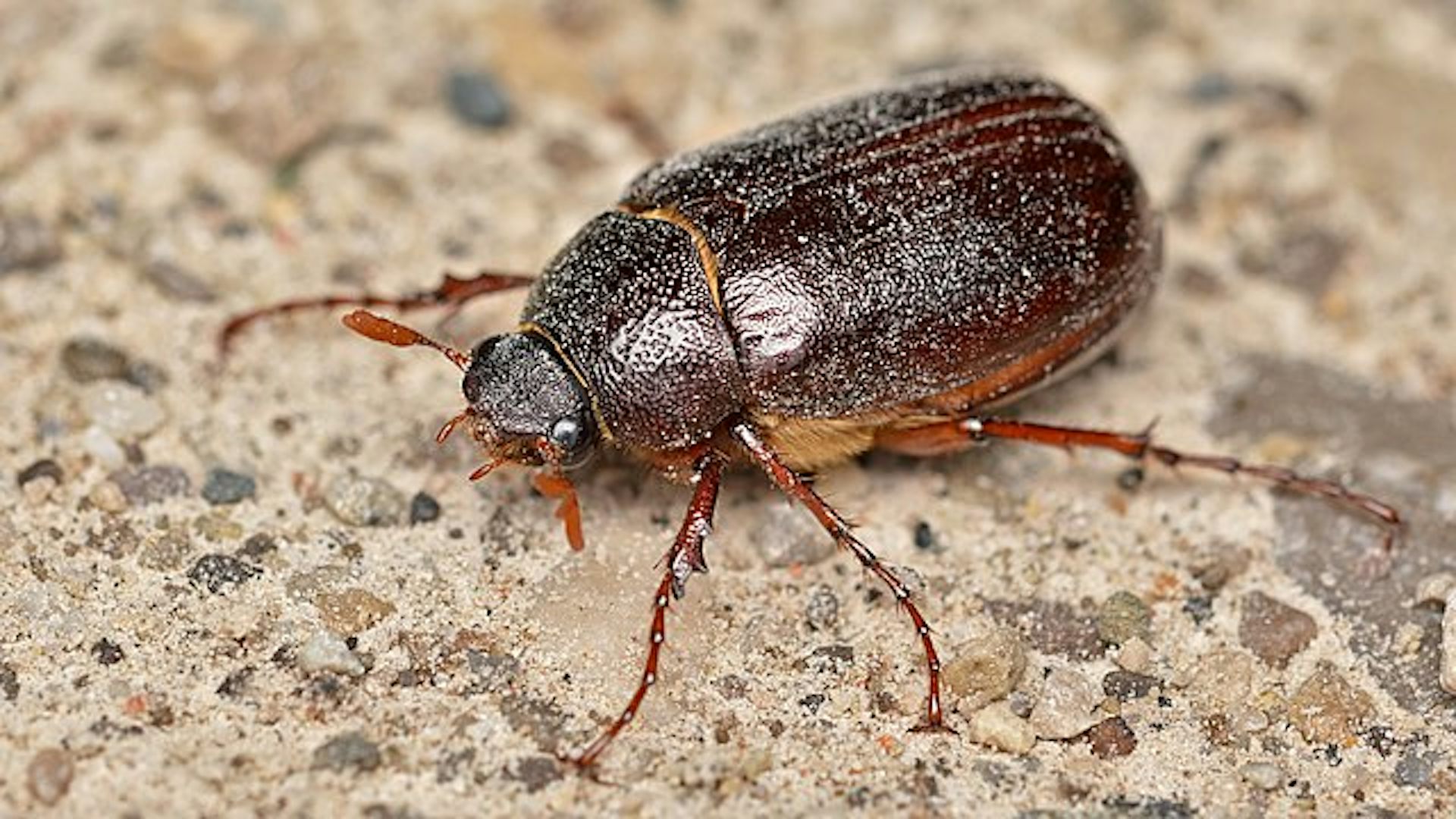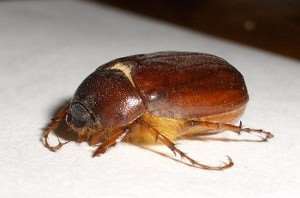1 Green June Beetle in the Landscape PDIC Factsheets
- Author: content.ces.ncsu.edu
- Published Date: 03/09/2022
- Review: 4.84 (709 vote)
- Summary: By May, larvae begin to pupate, and adults develop within 2 to 3 weeks. They emerge to mate in July and August, becoming most abundant around the time that
- Source: 🔗
2 June beetle | Description, Life Cycle, & Facts – Britannica
- Author: britannica.com
- Published Date: 01/06/2022
- Review: 4.71 (446 vote)
- Summary: Each female buries between 50 and 200 small pearl-like eggs in the soil. After three years of feeding on plant roots, the larvae pupate, emerge as adults in
- Source: 🔗
3 Pest … or snack? June bugs are the croutons of the sky
- Author: theconversation.com
- Published Date: 07/18/2022
- Review: 4.58 (593 vote)
- Summary: · Just like butterflies and moths, June bugs grow through a process known as “holometabolous development.” They pass through several stages: egg,
- Matching search results: One of the remarkable species that feeds on June bugs is Pelecinus polyturator. It is a large wasp (about seven centimetres long) that primarily reproduces asexually, and is found from northern Argentina to southern Canada. Pelecinus polyturator …
- Source: 🔗
4 Green June Beetle | Oklahoma State University
- Author: extension.okstate.edu
- Published Date: 01/08/2022
- Review: 4.23 (381 vote)
- Summary: Life Cycle. This insect overwinters as a nearly mature larva in the soil. They feed and finish maturing in the spring and pupate in a cell in the soil
- Matching search results: One of the remarkable species that feeds on June bugs is Pelecinus polyturator. It is a large wasp (about seven centimetres long) that primarily reproduces asexually, and is found from northern Argentina to southern Canada. Pelecinus polyturator …
- Source: 🔗
5 How Long Do June Bugs Live?
- Author: birdsandwild.com
- Published Date: 02/16/2022
- Review: 4.15 (493 vote)
- Summary: June bugs live for around 2-4 years. Most of the June bugs’ life is spent as a grub underground. June bugs remain as grubs for around 1-3 years. Once they
- Matching search results: During this stage, the June bug stays underground whilst it undertakes lots of physical changes. The June bug will create a cocoon-like structure and stay in the same spot during this time. This makes the pupae vulnerable to parasitic predators as …
- Source: 🔗
6 Blog What Are June Bugs?
- Author: plunketts.net
- Published Date: 05/07/2022
- Review: 3.79 (370 vote)
- Summary: · The June Bug Life Cycle … Female June bugs lay 50-200 eggs below the ground surface from midsummer to fall. In 3-4 weeks, the larvae (grubs)
- Matching search results: During this stage, the June bug stays underground whilst it undertakes lots of physical changes. The June bug will create a cocoon-like structure and stay in the same spot during this time. This makes the pupae vulnerable to parasitic predators as …
- Source: 🔗
7 How to Get Rid of June Bugs: 5 Easy Methods
- Author: thespruce.com
- Published Date: 05/30/2022
- Review: 3.69 (208 vote)
- Summary: · Depending on the species, the life cycle of a June bug from egg to grub to pupa to adult can take one to three years. It begins when adult June
- Matching search results: During this stage, the June bug stays underground whilst it undertakes lots of physical changes. The June bug will create a cocoon-like structure and stay in the same spot during this time. This makes the pupae vulnerable to parasitic predators as …
- Source: 🔗
8 June Bugs – ExperiGreen
- Author: experigreen.com
- Published Date: 01/05/2022
- Review: 3.53 (499 vote)
- Summary: · The adult June Bug lays hundreds of eggs in the early summer. When the larvae [grubs] hatch in mid to late summer, they feed on grassroots,
- Matching search results: During this stage, the June bug stays underground whilst it undertakes lots of physical changes. The June bug will create a cocoon-like structure and stay in the same spot during this time. This makes the pupae vulnerable to parasitic predators as …
- Source: 🔗
9 June Bugs – How to Control and Eliminate These Irritating Pests

- Author: trees.com
- Published Date: 10/30/2021
- Review: 3.25 (549 vote)
- Summary: · Life Cycle of a June Bug. After mating in early summer, June bugs dig into the preferably moist and organic soil of lawns or turf to lay
- Matching search results: The Phyllophaga species, which literally translates to ‘leaf eater,’ is often mistaken for the cockroach due to it’s hard, shiny body. This species can be identified by its brown and shiny exterior, its hairy underbelly, six legs, and a pair of …
- Source: 🔗
10 Pest . . . or snack? June bugs are the croutons of the sky

- Author: dal.ca
- Published Date: 08/17/2022
- Review: 3.09 (476 vote)
- Summary: · June bugs can be serious pests of ornamental and agricultural … bird species consume June bugs across all stages of their life cycle
- Matching search results: June bugs are attracted to light, which means we often encounter them at windows and streetlamps in early summer. Due to their large size and distinctive appearance, they are rather conspicuous among the millions of other insect species we share our …
- Source: 🔗
11 June Bug: Life Cycle, Facts & Characteristics – Study.com
- Author: study.com
- Published Date: 07/11/2022
- Review: 2.83 (123 vote)
- Summary: Their life cycle is as follows: egg » larva » pupa » adult . Adults lay eggs in May and June, which hatch two and a half weeks later into small white larva, also known as grubs. Grubs go through three stages, or instars. For each of these, the grub molts, sheds its skin, and gets bigger
- Matching search results: June bugs are attracted to light, which means we often encounter them at windows and streetlamps in early summer. Due to their large size and distinctive appearance, they are rather conspicuous among the millions of other insect species we share our …
- Source: 🔗
12 June Bug | Pest Management – Farms.com

- Author: m.farms.com
- Published Date: 05/23/2022
- Review: 2.87 (198 vote)
- Summary: About June Bugs. Reproduction and Life Cycle. Annually, June bugs complete one generation. After mating, females dig into moist turf to lay a compact
- Matching search results: Fully mature June bugs are about ¾ to 1 inch long. The upper surface of the adult body is silky green to dull brown with green stripes running lengthwise and yellow to orange margins on the hard, front wings. The underside of a June bugs body is …
- Source: 🔗
13 How to Get Rid of June Bugs
- Author: bobvila.com
- Published Date: 02/04/2022
- Review: 2.72 (85 vote)
- Summary: · While you might only be focused on one part of a June bug’s life cycle–the end–knowing your enemy from cradle to grave is key to eliminating
- Matching search results: Your efforts to eliminate other insects might also be contributing to their proliferation. Wasps, for example, are natural predators of grubs. By taking out a wasps nest you might be inadvertently helping your grub population. The height of your …
- Source: 🔗
14 June Bug | Introduction, Life Cycle & Remedies
- Author: ibiologia.com
- Published Date: 11/06/2021
- Review: 2.52 (155 vote)
- Summary: · The life cycle of June bug starts from the egg. Female June bug lay eggs during midsummer about 2 to 5 inches deep in the soil
- Matching search results: Your efforts to eliminate other insects might also be contributing to their proliferation. Wasps, for example, are natural predators of grubs. By taking out a wasps nest you might be inadvertently helping your grub population. The height of your …
- Source: 🔗
15 Life Cycles of June Bugs
- Author: animals.mom.com
- Published Date: 07/29/2022
- Review: 2.48 (167 vote)
- Summary: Life Cycles of June Bugs · Egg. June bug life begins with the egg. · Larvae. Upon hatching from the eggs, June bugs enter their initial larval instar. · Pupa. This
- Matching search results: Your efforts to eliminate other insects might also be contributing to their proliferation. Wasps, for example, are natural predators of grubs. By taking out a wasps nest you might be inadvertently helping your grub population. The height of your …
- Source: 🔗
16 Turfgrass – May/June Beetle Grubs
- Author: entomology.unl.edu
- Published Date: 11/09/2021
- Review: 2.41 (84 vote)
- Summary: Phyllophaga (May beetle or June beetle) grubs require three years to complete their life cycle. Adult May/June beetles are larger than masked chafers (5/8
- Matching search results: Your efforts to eliminate other insects might also be contributing to their proliferation. Wasps, for example, are natural predators of grubs. By taking out a wasps nest you might be inadvertently helping your grub population. The height of your …
- Source: 🔗
17 What Do June Bugs Eat? Learn Their Diet, Life Cycle, and How To Stop Them
- Author: romneypestcontrol.com
- Published Date: 04/13/2022
- Review: 2.3 (146 vote)
- Summary: · The life cycle of the June bug begins early in the summer during mating season. A female June Bug will lay her eggs in multiple groups for a
- Matching search results: It’s not necessary to use harmful chemicals to get rid of June Bugs. Using Bacillus thuringiensis var. Kurstaki, commonly known as BT, is an organic and non-toxic way to get rid of grubs in your lawn. You can also use dish soap to kill grubs in the …
- Source: 🔗
18 June beetle – Extension Entomology – Texas A&M University
- Author: extensionentomology.tamu.edu
- Published Date: 09/11/2022
- Review: 2.13 (71 vote)
- Summary: · In 3 to 4 weeks, small grubs (larvae) hatch from eggs and develop through three stages (instars), with the first two stages lasting about 3
- Matching search results: It’s not necessary to use harmful chemicals to get rid of June Bugs. Using Bacillus thuringiensis var. Kurstaki, commonly known as BT, is an organic and non-toxic way to get rid of grubs in your lawn. You can also use dish soap to kill grubs in the …
- Source: 🔗
19 This Months Bug: The June Bug
- Author: catseyepest.com
- Published Date: 03/01/2022
- Review: 2.04 (78 vote)
- Summary: · June bugs have a one-year life cycle. Females lay their eggs mid summer, and larva hatch into grubs about 18 days later. The grubs molt twice
- Matching search results: It’s not necessary to use harmful chemicals to get rid of June Bugs. Using Bacillus thuringiensis var. Kurstaki, commonly known as BT, is an organic and non-toxic way to get rid of grubs in your lawn. You can also use dish soap to kill grubs in the …
- Source: 🔗
20 May/June Beetles – Wisconsin Horticulture

- Author: hort.extension.wisc.edu
- Published Date: 05/13/2022
- Review: 2.09 (112 vote)
- Summary: Life Cycle: All May/June beetles in Wisconsin have three-year life cycles (except for the widely distributed Phyllophaga tristis which has a two-year life
- Matching search results: Damage: May/June beetles are pests of turfgrass, ornamentals, Christmas trees, cranberries, and certain vegetable and field crops. Adults have been documented to cause foliar damage to ornamental plants, such as oaks and other trees. This type of …
- Source: 🔗
